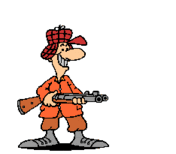Post by Woody Williams on Nov 27, 2005 13:33:03 GMT -5
www.canada.com/calgaryherald/news/story.html?id=2625c70e-baeb-4509-9edc-a6783746e43b
Nova Scotia poachers no match for robo-moose
Charles Mandel
CanWest News Service
Saturday, November 26, 2005
Robotic moose deployed by Nova Scotia's Department of Natural Resources
are being used to capture poachers in the province's forests.
So far, the remote-controlled animals -- one of which is named
Bullwinkle -- have bagged eight illegal hunters.
Mainland moose are an endangered species in Nova Scotia, where an
estimated 1,000 animals remain in the wild. Poaching them carries a fine
of $500,000 or six months in jail, or both.
The robots are so realistic that when shot they collapse just like real
moose and look up at the hunter's approach. They are also so resilient
they're able to withstand damage from bullets.
"It's amazing. He can be shot 50, 100 times, and we're not going to have
to do a repair," says John Mombourquette, the director of the provincial
enforcement division.
The animated animals weigh under 27 kilograms, cost $2,000 and come in
three pieces. Wildlife officers are able to assemble one and set it up
in the woods within five minutes.
Made from a dense styrofoam-like material, the moose can lift and lower
their heads, sniff the air and move limited distances.
The electronics controlling the moose are located in the back of the
lower parts of the legs, areas where wildlife officers don't expect the
moose to be shot.
Alain Larochelle manufactures the moose in the basement of his
Victoriaville, Que., home.
He's been making robotic animals for 15 years, including robotic deer
and turkeys. Larochelle sells his animals to game wardens across Canada
and the United States.
It takes Larochelle two weeks to build a single moose. But Mombourquette
appreciates the work that goes into creating each animal. "He's very
artistic to be able to craft these things identical to the actual
beast."
At least two robo-moose are staked out in the woods, but Mombourquette
says because of ongoing investigations he is not at liberty to say
precisely how many fake moose might be standing in provincial forests.
When deployed, the moose are not alone. As many as six wildlife officers
may accompany a moose on the job. Remote-control surveillance cameras
might be used during an investigation and take-downs are often recorded
on video camera.
"We're not out here on a fishing expedition," Mombourquette says. "These
investigations are long-term. They're targeted. We're not out there to
entice someone to shoot a moose."
The province is counting on the robots to deter poachers.
The Calgary Herald 2005
Nova Scotia poachers no match for robo-moose
Charles Mandel
CanWest News Service
Saturday, November 26, 2005
Robotic moose deployed by Nova Scotia's Department of Natural Resources
are being used to capture poachers in the province's forests.
So far, the remote-controlled animals -- one of which is named
Bullwinkle -- have bagged eight illegal hunters.
Mainland moose are an endangered species in Nova Scotia, where an
estimated 1,000 animals remain in the wild. Poaching them carries a fine
of $500,000 or six months in jail, or both.
The robots are so realistic that when shot they collapse just like real
moose and look up at the hunter's approach. They are also so resilient
they're able to withstand damage from bullets.
"It's amazing. He can be shot 50, 100 times, and we're not going to have
to do a repair," says John Mombourquette, the director of the provincial
enforcement division.
The animated animals weigh under 27 kilograms, cost $2,000 and come in
three pieces. Wildlife officers are able to assemble one and set it up
in the woods within five minutes.
Made from a dense styrofoam-like material, the moose can lift and lower
their heads, sniff the air and move limited distances.
The electronics controlling the moose are located in the back of the
lower parts of the legs, areas where wildlife officers don't expect the
moose to be shot.
Alain Larochelle manufactures the moose in the basement of his
Victoriaville, Que., home.
He's been making robotic animals for 15 years, including robotic deer
and turkeys. Larochelle sells his animals to game wardens across Canada
and the United States.
It takes Larochelle two weeks to build a single moose. But Mombourquette
appreciates the work that goes into creating each animal. "He's very
artistic to be able to craft these things identical to the actual
beast."
At least two robo-moose are staked out in the woods, but Mombourquette
says because of ongoing investigations he is not at liberty to say
precisely how many fake moose might be standing in provincial forests.
When deployed, the moose are not alone. As many as six wildlife officers
may accompany a moose on the job. Remote-control surveillance cameras
might be used during an investigation and take-downs are often recorded
on video camera.
"We're not out here on a fishing expedition," Mombourquette says. "These
investigations are long-term. They're targeted. We're not out there to
entice someone to shoot a moose."
The province is counting on the robots to deter poachers.
The Calgary Herald 2005



